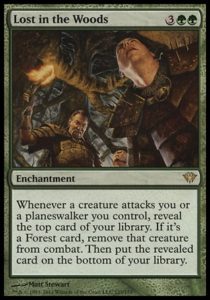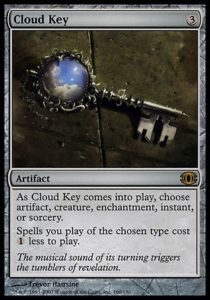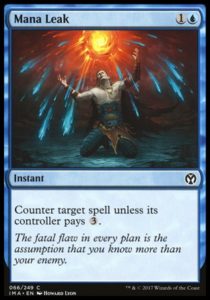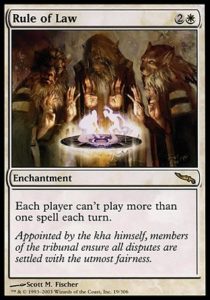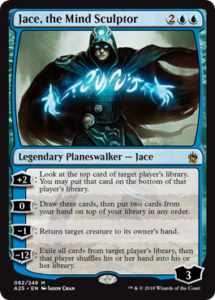Over the course of Masters 25 spoilers spoiler week, I found myself increasingly anxious. As a Limited lover, I care most about commons and uncommon spoilers, but I wasn’t seeing what I always look for and always find. Where were the cards communicating mechanical themes? Where were the keyword or ability word mechanics? Where were the signposts for each color combination? Every single Masters format and essentially every single Limited format gives some indication of how you’re supposed to draft it. Even Modern Masters 2017, which mostly broke down to multicolor decks (with blink/control/token subthemes) and swarm aggro decks, had some themes to build around.
Looking at the Masters 25 full spoiler, I don’t see many distinct archetypes. There are oodles of synergies between individual cards and a Coldsnap-esque focus on drafting as many copies of the same card as possible, but that’s about it. This isn’t necessarily a problem, but it, alongside several public comments from Wizards’ designers suggest that this is both deliberate and indicative of future Masters sets.
Today, we’ll dive into a whole host of topics: the makeup of Masters 25, the future of the Masters product line, and Wizards’ design philosophy behind such products. We’ve got a lot to cover, so let’s get started!
Missing Signposts
Most sets today have support for all ten color pairs and a cycle of uncommon multicolor cards to reward and guide two color drafters. This isn’t a firm rule: pre-Rivals Ixalan draft had scant support for WU and BG, while MMA 2017 encouraged players to draft multicolor goodstuff decks without much regard to which colors they were in (though multicolor decks were rewarded for being blue and aggro decks wanted to be red).
Signposting has somewhat ebbed with recent Masters products: MMA 2013, MMA 2015, EMA all had distinct archetypes for all ten color pairs. MMA 2017 went multicolor-heavy (which understandably makes designing ten distinct strategies harder when the goal is to draft all the colors). IMA combined overt archetypes like BG Dragons and WB Lifegain with more diffuse ones, like Jeskai colors mostly caring about Prowess and RG, er, X-spells. We’ve seen diffuse archetypes in earlier products (like WB self-bounce in EMA or BG sacrifice in MMA2015), but we are increasingly seeing archetypes not defined in mechanical terms or communicated via signpost gold uncommons. Looking at the ten gold uncommons in Masters 25 one sees generically powerful cards that suggest a speed of a deck (Watchwolf and Blightning work best in aggressive decks, whereas Cloudblazer and Lorescale Coatl reward longer games), but nothing that is an engine for a mechanic-based archetype.
The data suggests that Masters formats are becoming more about powerful cards rather than archetypes reliant on context-sensitive cards. Let’s define that term.
Context is Key
One of the most important factors (in my opinion, which this whole article admittedly is) in whether a Limited format is good is context-sensitive cards. Here’s an example:
Path to Exile was the best uncommon in MMA 2013. It went in every white deck and was great in all of them, regardless of archetypes. Contrast this with Dispatch in MMA 2015. It was unplayable outside of Affinity but better than Path to Exile in it. Path to Exile is awesome regardless of context, whereas Dispatch is a reward for building a deck to maximize its utility. Dispatch is a much more context-sensitive card.
When there are sufficient context-sensitive cards, you get dynamic pick orders, where drafters in overlapping colors have drastically different means of evaluating cards. In Ixalan, a green-blue merfolk drafter and a red-green dinosaur can sit next to each other and get plenty of playables in green because their archetypes make different cards better or worse; Pounce is excellent when you have massive dinosaurs, but weak when you’re assembling an army of 1/1s and 2/2s.
The Value of Archetypes
Innistrad, Khans, Hour of Devastation, and Masters sets rank among the most popular Limited formats of all time because they have incredibly dynamic pick orders. Drafting well involved recognizing which archetypes are open, which synergies are best for the given situation, and being mindful of when to switch gears (if possible). Importantly, these formats have dynamic pick orders because they are all in a state of balance: if individual cards are too strong (or too many cards are weak), you get Magic 2014 or Avacyn Restored, where only a small handful of cards are good and each draft plays out relatively the same. If synergies are overwhelmingly strong, you have to commit early, force an archetype, and hope it’s open, as was the case in Lorwyn. Interestingly enough, Ixalan (before Rivals) managed to hit both of these negative extremes.
I enjoyed Iconic Masters, but I felt both it and MMA 2017 had less dynamic pick orders than I’d experienced in MMA 2013, MMA 2015, and EMA. Iconic Masters had two loose themes spread over three colors (+1/+1 counters in Abzan and Prowess in Jeskai) and some very weak themes (UB didn’t really need to be about mill and RG didn’t really have a theme), meaning more decks prioritized the same cards and more archetypes were functionally the same. Many color combinations felt defined less by synergy and more by the raw power of having four common mana rocks. I got bored more quickly (which wasn’t helped by the various other factors that made IMA nearly impossible to draft past release weekend).
The biggest concern I have is that it seems Wizards has embraced this trend wholeheartedly.
Intentional Design
Two weeks ago, Gavin Verhey’s enlightening article, The Future of Masters, discussed Wizards’ positions on the Masters product line. He acknowledged that Masters products have two distinct audiences (with a strong overlap between the two): people who want valuable cards reprinted and people who “like the unique and highly complex power level of these sets.” A substantial percentage of Masters lovers care about the draft format, so they’re ensuring they design Limited to their satisfaction. Going forward, Masters products are going to have much broader appeal (such as focusing towards Commander players, a massive audience) and be focused around themes rather than formats. Iconic Masters is serving as the template for this new era of the product line, and while it had some problems, he considers it a strong Limited environment.
I disagree with his position that IMA’s draft format was a step in the right direction, but looking at what other Wizards employees have said, I recognize both that I may not be right and that this was a deliberate decision made by a strong consensus of WotC designers.
Last week, Ethan Fleischer, a senior game designer at WotC and winner of the second Great Designer Search posted the following:
#MTGM25‘s loose structure and relative lack of keyword mechanics allowed us more room for more individually-adorable cards. Cards like… Stangg! 😊 #WOTCstaff
— Ethan Fleischer (@EthanFleischer) March 1, 2018
Mark Rosewater, when asked about the theme of Masters 25, said the following: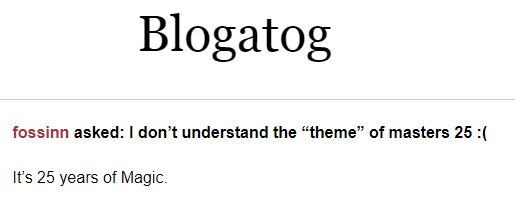
Masters 25 is not a Limited format where players have to navigate distinct archetypes and context-sensitive cards (spoilers: Cloudshift goes with everything). Instead, it’s a high-powered format that surveys Magic’s wondrous 25 years of history. I’m not excited for that. I’ve played a format before where all cards were powerful, archetype synergy was lacking, and there were lots of cool shenanigans to be had—it was called Legendary Cube. I prefer formats like Vintage or Legacy Cube, where yes there are insanely powerful cards, but most require more support than simply playing the correct basics.
The Future of Masters Products
Masters 25 and the designer commentary suggests that I’m not longer within the target demographic of Masters products. That’s disappointing, given that they rank among my favorite Limited formats of all time. Still, the writing has been on the wall for some time: I’m a Spike/Timmy, and there hasn’t been a high level tournament to justify getting good at a Masters format in three years.
It would be both haughty and blatantly false to think everything should be designed for me. Magic makes plenty of products, like Planeswalker Decks, Commander precons, and Planechase that I don’t buy. They benefit me by reducing prices and occasionally providing cards for Cube, but they’re not meant for me. Magic knows their audience, and I believe they’ve decided to stop targeting the Masters line to me and people like me. It’s sad, but I still have regular Limited and Cube, as well as the prospect of unexpected joys like Unstable and Conspiracy.
I wonder if this demographic shift will bear fruit. I have only anecdotal data on how casual players—the overwhelming majority of Magic players and purchasers—spend their money. Masters 25 could succeed where IMA failed thanks to better chase cards, better advertising, and better timing of release. Or it could be a premium product intended for people less interested in paying a premium price. Only time will tell. And hell, I could be completely wrong about the Limited format—perhaps it’s incredibly deep, where every draft decision is agonizing as one tries to assemble an archetype on the fly out of cards with unspeakably beautiful watermarks. I like Chaos draft, and perhaps Masters 25 is trying to simulate that. Only time will tell.
And, as always, thanks for reading.
—Zachary Barash
Zachary Barash is a New York City-based game designer. He works for Kingdom Death: Monster, has a Game Design MFA from the NYU Game Center, and does freelance game design. When the stars align, he streams Magic.
His favorite card of the month is Heart Warden. It’s a Mind Stone Elf that’s more fair, has more utility, and will hopefully be reprinted sometime soon, perhaps in a Masters set!

